Week #15. Here come the tomatoes.
- On: August 28, 2019
 0
0
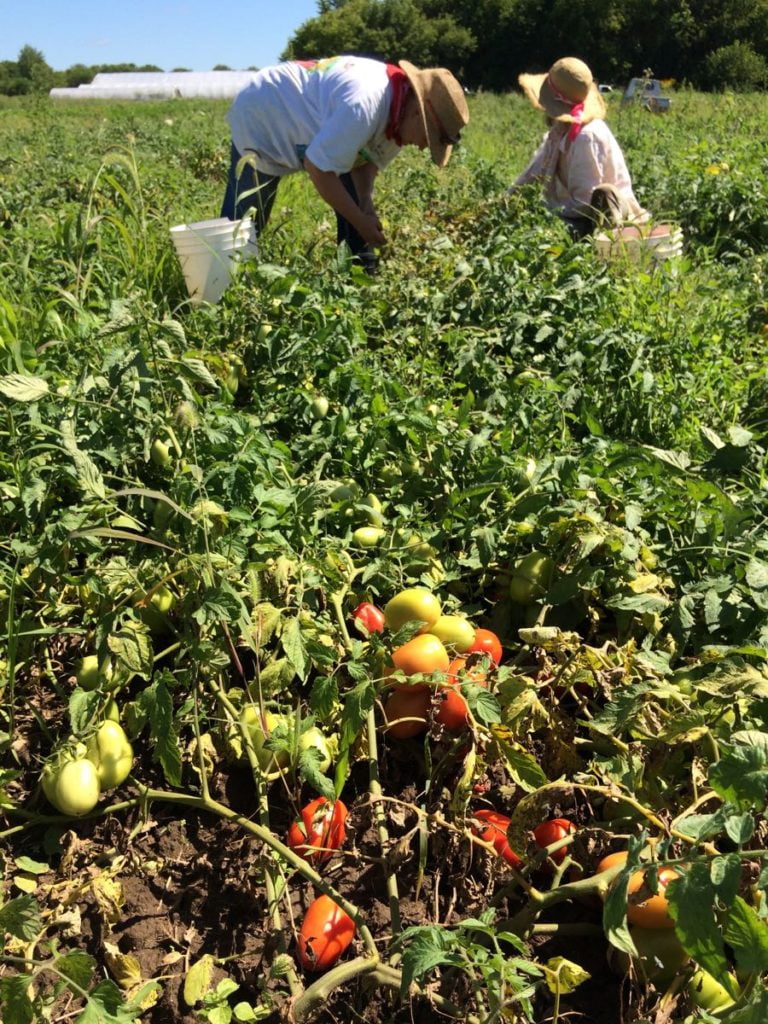
Now our tomato harvests begin in earnest. Linda and Kerry harvest plum tomatoes.
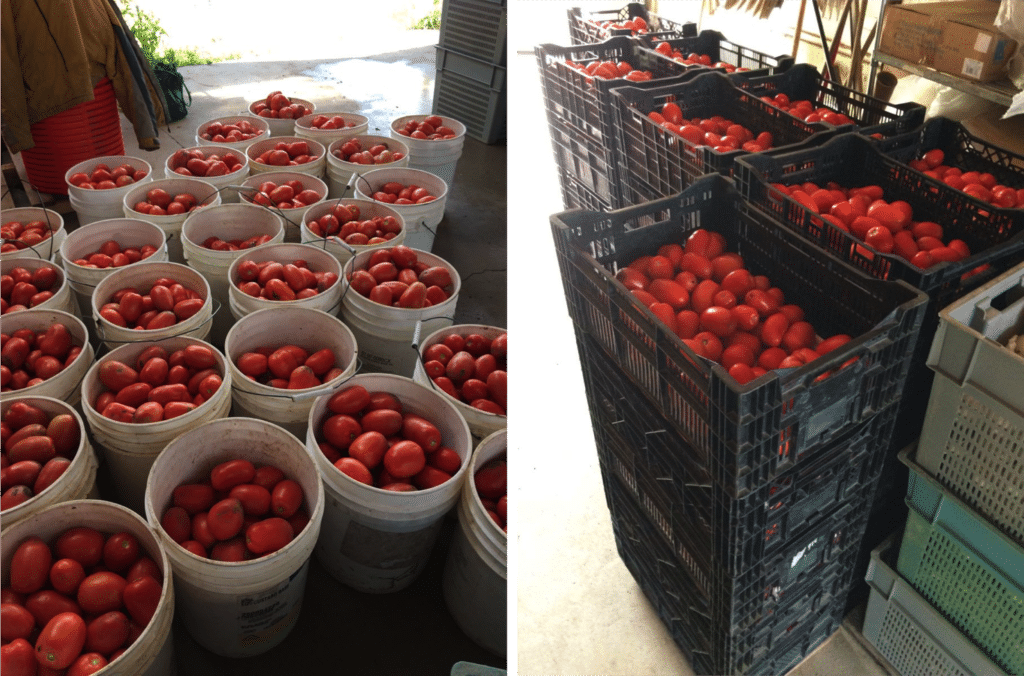
Some of this week’s tomatoes, before weighing and bagging.
Let’s talk tomatoes
They are a big part of our lives right now. We have transitioned from tomato planting #1 to our much bigger tomato planting #2. You should notice a jump in quality, as this week’s tomatoes were all picked from younger plants. As tomato plants age, the tomato flavor and quality decline. This is typical with organic tomatoes; our options to control diseases are limited. We, and the crew, and all of you will appreciate the switch to a new field.
We will have lots of tomatoes for you in September, weather- and disease-permitting. This field is ripening late, mostly due to the cool spring weather. We will pack many in the CSA boxes. We expect to offer bulk plum &/or slicing tomatoes for sale to CSA members. We’re also planning a members-only plum tomato u-pick in September, date TBD. Watch for emails with more information about the u-pick and the bulk sales.
Progress with basil!
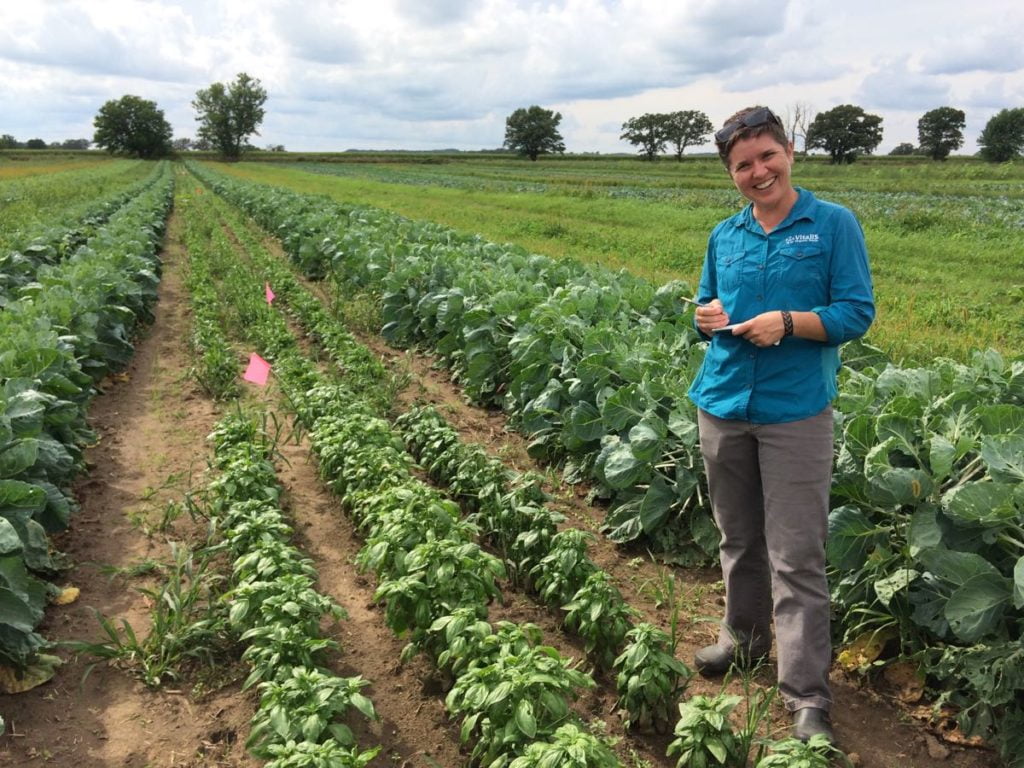
We host basil trials for plant breeder Adrienne Skelton of Vitalis Organic Seeds. She visited last week to see how her breeding lines are faring.
Once again, we are battling Basil Downy Mildew (BDM), a disease that risks our basil crop most years. After years of struggle with BDM, we are making progress. BDM showed up on our farm in 2010, shortly after it was discovered in the US for the first time. Spores have to blow into Wisconsin each year – it doesn’t survive our cold winters. The best tool in this situation is plant resistance. There’s been a worldwide effort to develop resistant varieties, and we had interesting ones to try this year. I planted varieties from Vitalis Seeds, from an Israeli breeding program, and from a program based at Rutgers University. This year’s varieties are a big improvement.
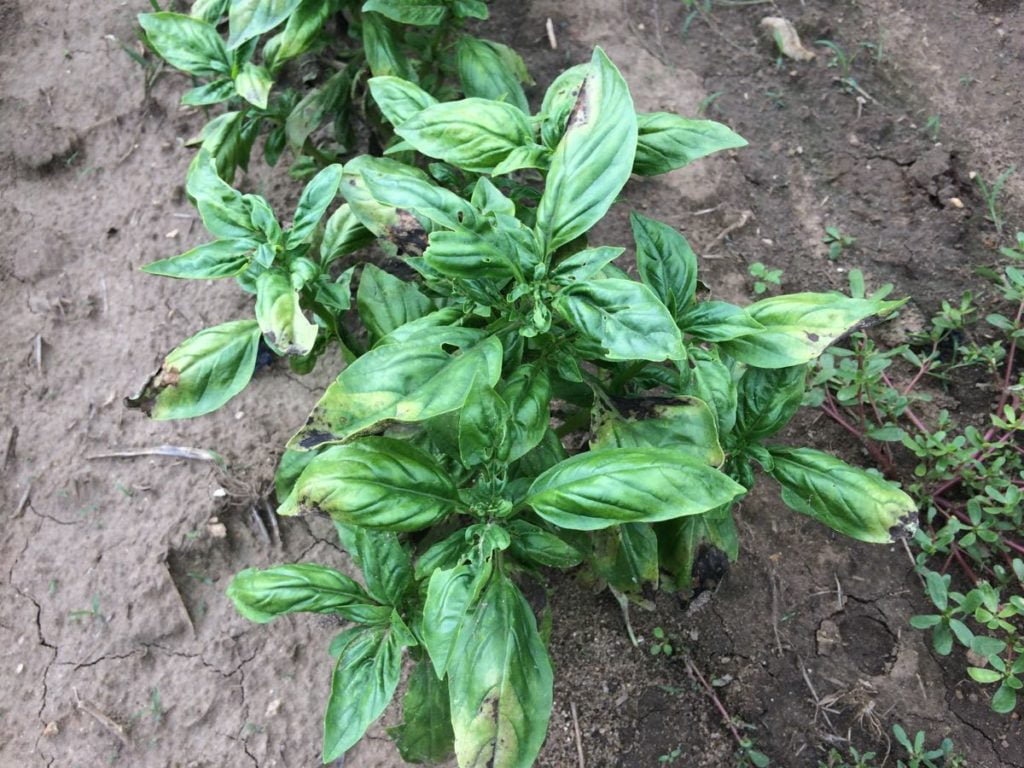
Susceptible basil infected with downy mildew. Look for the yellow and brown patches on the leaves.
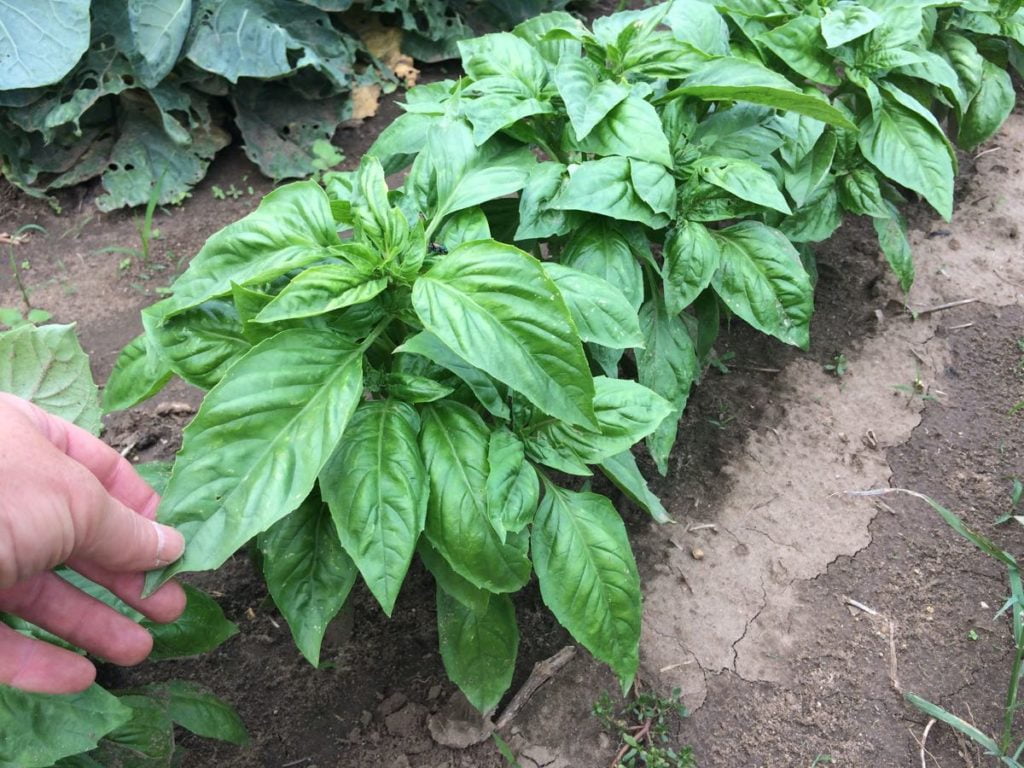
The new ‘Prospero’ variety grown in the same field, but with almost no disease. This is a big improvement! This variety was selected in an Israeli breeding program.
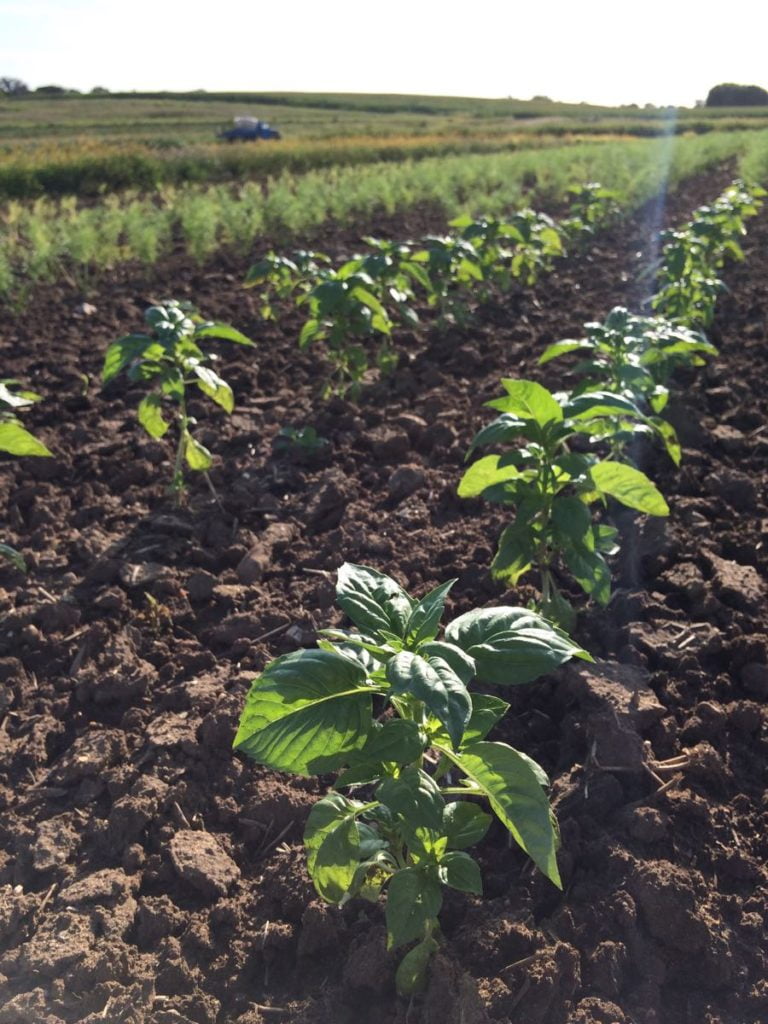
Because of BDM, we have to plant multiple basil fields, then harvest the plants young. Usually four or five basil plantings per year, with two harvests per planting, maybe three if we’re lucky. You can have low levels of BDM in a field but it doesn’t explode until the canopy closes. It’s the humidity. We have to harvest the basil before the plants are touching each other. Also, I scout our basil fields a lot. If I find a small amount of DM, I cut the plants at the soil, put them in a plastic bag, and put the bag in the sun to solarize.
Harvesting young means the quality is excellent, but the plants don’t have a chance to bulk up. As a result, we are unlikely to have bulk basil to sell to you folks. It’s too precious and scarce and we need it all for the CSA boxes. I will let you know if this changes with the new resistant varieties. By next year, I expect to be able to sell bulk basil again. Beth
Cucumber updates
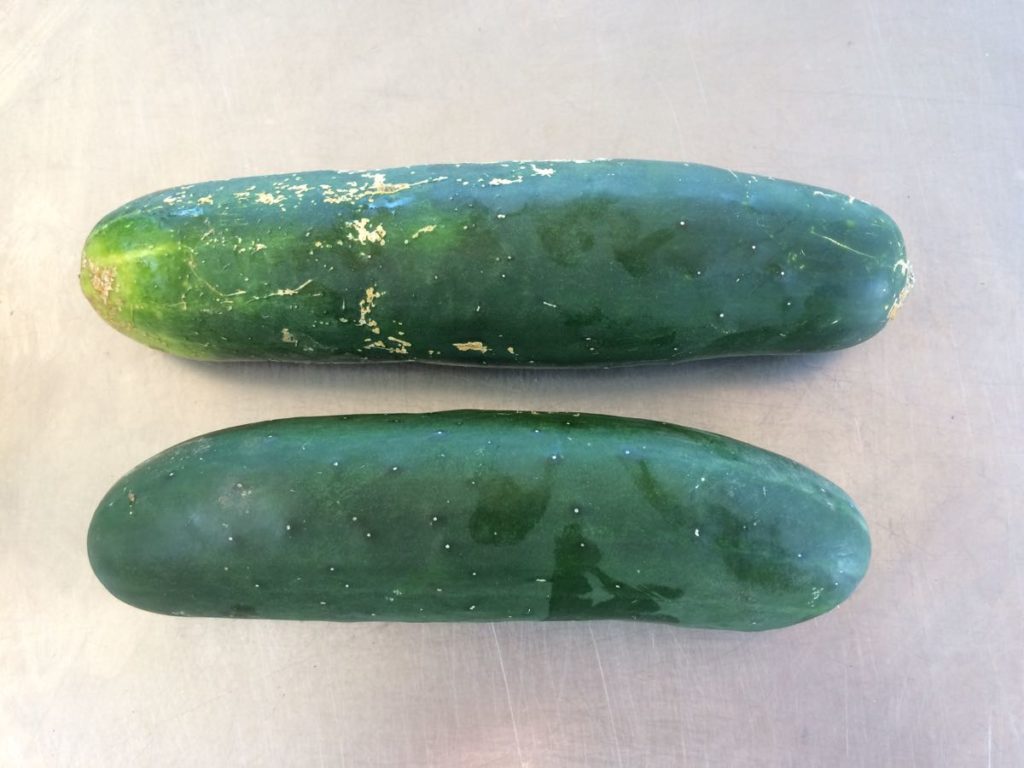
We are transitioning between cucumber fields. The top cucumber is from a field we just finished harvesting. The scarring accumulates from bug damage and from handling the plants during harvest. The cucumbers taste fine but you’ll want to peel these ones. The pretty, unscarred cucumber at bottom is the first harvest from a new field.
We experimented with direct seeding cucumbers this year, a way to avoid the effort of growing and transplanting seedlings. Transplants are useful in spring; they let us get a jump on the season. By summer, that’s less valuable. We planted seeds directly, cultivated with the tractor to keep the weeds down, and now we have a nice small patch of fresh cucumbers to harvest. We’ll do this again.
Get ’em while they’re young

Chance, Andrew, Ari, Riley and Owen. Billy (at right) manages the group.
Our high school employees are finished for the season. This is a good group of kids and we will miss their help. We routinely hire four or five high school students to work over summer break. It’s a good job for teenagers. We limit their hours to 8 am to 12 noon, and send them home before it gets too hot. It gets them out of bed in the morning, then they have the rest of the day to themselves. Their work is more routine than our main crew, who handle a wide variety of vegetables with finesse. The high school employees weed, pick peas, strawberries and beans, and harvest many, many onions.
This group did something different. One day, we were under intense pressure, with too much work and too little time. We were faced with a choice of which crop to harvest, knowing that the neglected crop would be lost for good. The high schoolers talked together, then approached us and offered to work in the afternoon too. They saved the day, and are the primary reason that you got big bags of peas earlier this year. No high school crew has done this. We were touched and impressed. Beth
Veggie List and Veggie Notes
Week #15, August 29/30, 2019 (Th/Fri sites)
– Weekly shares
– EOW/ purple
– Sampler/ sun
Sweet corn, 8 or 9 ears
Watermelon, yellow (most sites) or red (one site)
Tomatoes, slicing & plum, 4.75 lb total
Bell peppers, red or green or yellow, ~2
Cucumber, green or silver, 1
Walla Walla onion, 1
White onion, 1
Jalapeno chile (HOT), 1
Basil, 1 small bunch
Garlic, 1 bulb
– Some sites get a small lettuce, and some sites get an extra cucumber.
– Everyone gets a few specialty peppers, of one type: Oranos snack peppers OR Jimmy Nardello frying peppers OR shishito peppers OR a red frying pepper. All the specialty peppers are sweet, although an occasional shishito will be hot.
Next week’s box will probably contain tomatoes, peppers, melon, onions, kale, carrots, garlic and more.
Sweet corn – This is the final corn delivery for the year. We hope you enjoyed it! This delivery is a mix of yellow corn plus a yellow-and-white bicolor. You might get one type or a mix.
Watermelon – Most sites get a yellow watermelon.
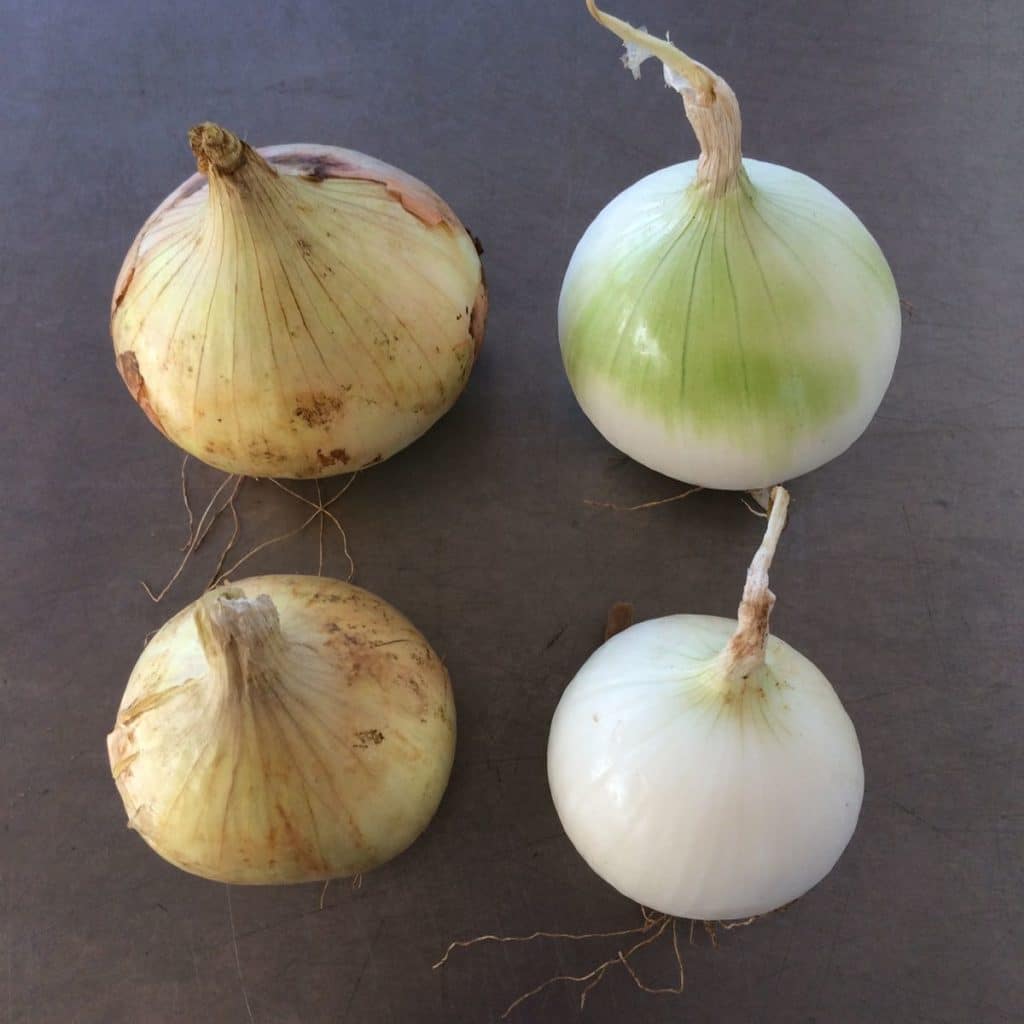
You’ll receive both a Walla Walla onion (left) and a white onion (right). Walla Wallas are sweet, excellent for salads or grilling. White onions are intermediate in pungency between sweet onions and yellow storage onions. They will fry better than a Walla Walla but not as well as a yellow storage onion. We’re sending these two types together because they have different uses, and you can tell them apart.
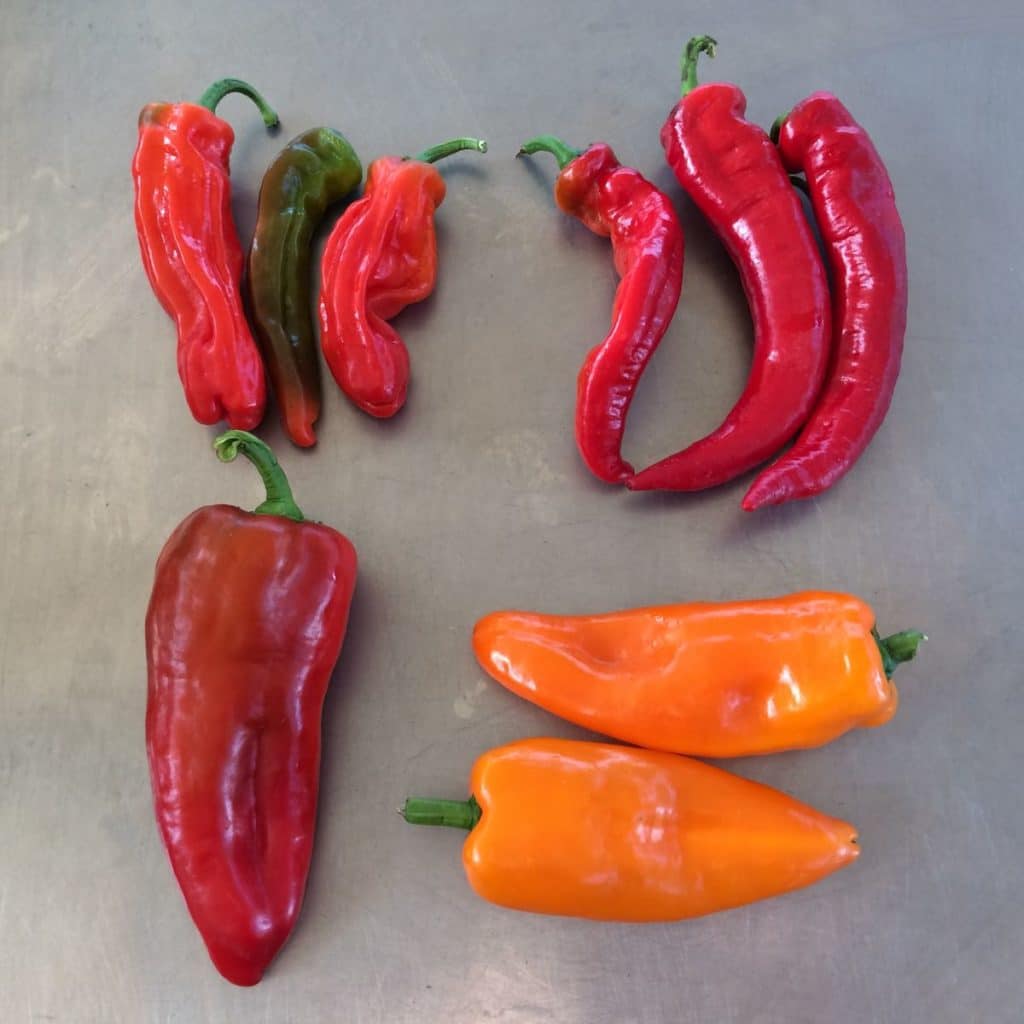
Each site gets one type of specialty pepper. Clockwise from top left; shishito peppers OR Jimmy Nardello frying peppers OR Oranos snack peppers OR a red frying pepper. All types are sweet, although the shishitos will occasionally be hot.
RECIPES
Visit our 2019 Recipe Log or our 2018 Recipe Log or join our Facebook discussion group.
LOCAL THYME/ Comforting Classics
Roman Chicken and Peppers
Corn and Pepper Frittata with Cheddar and Bacon
Pesto Baked Tomato
Cajun Kale and Corn Salad
LOCAL THYME/ Outside the Box Recipes
Jalapeño and Corn Studded Cheddar Polenta with Roasted Pepper Salsa
Grilled Corn with Miso Butter
Whole Wheat Pasta with Chunky Pine Nut Sauce and Marinated Tomatoes
Hamburgers with Romesco Sauce (or choose your fave veggie burger)
LOCAL THYME/ Quick and Easy Meal
Turkey and Bacon Sandwich with Lightly Pickled Vegetables
????????????
RECIPES FROM LAUREN
TOMATO & SWEET CORN PASTA SALAD
Serves 8-12 as a side.
Takes 40 minutes.
1 pound pasta, the type is your choice
4 ears corn, husks removed
1 cucumber or silver slicer, seeded and diced
1/2 Walla Walla onion
1 pound tomato, seeded and roughly chopped
1 jalapeno, diced
1/2 cup basil leaves, roughly chopped
Dressing:
1/4 cup mayo
1/4 cup Greek yogurt
1 tablespoon white wine or white vinegar
1 tablespoon kosher salt
1/2 tablespoon sugar
1/2 teaspoon freshly ground black pepper
- Bring a large pot of well-salted water to a boil on the stove over high heat. Once boiling, add pasta and cook to al dente according to package directions.
- While pasta cooks, prepare your dressing by whisking together all ingredients.
- Drain pasta in a colander and let sit for a minute to lose some of the water, then add to a large bowl. Add dressing to noodles while they’re still warm and toss to combine. Set aside.
- Refill stock pot with salted water and bring to a boil. Once boiling, add sweet corn and cook for 4 minutes. Meanwhile, chop your other veggies. Rinse corn under cold water to cool and then cut off kernels with a knife. Add cucumber, onion, tomatoes, jalapeno, corn, and basil to bowl. Toss to combine.
- Taste and adjust salt and pepper as desired.
.
????????????
.
MARINATED TOMATO SALAD
Serves 4-6.
Takes 20 minutes, plus time to chill.
6 plum tomatoes, cut into large chunks or wedges (or 1 pint cherry tomatoes, halved)
3 bell or sweet peppers, any color, diced
1 white onion, diced
1 cup (or so) pitted whole black olives
Dressing:
2/3 cup vegetable oil
1/4 cup vinegar
1/4 cup fresh basil, loosely chopped
1/4 cup minced garlic
1 teaspoon salt
1/4 teaspoon pepper
1 teaspoon sugar
1/2 teaspoon dried parsley
1/2 teaspoon dried marjoram
- Place all sliced vegetables in a large bowl. Add olives.
- Whisk together dressing ingredients and pour over vegetables. Refrigerate 3-4 hours before serving.
.



